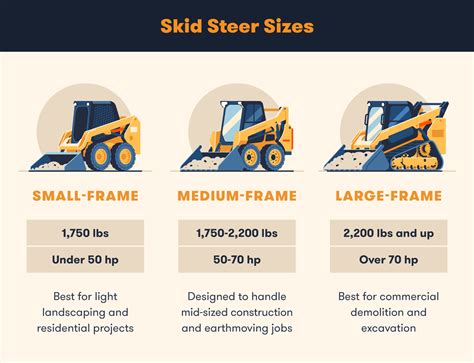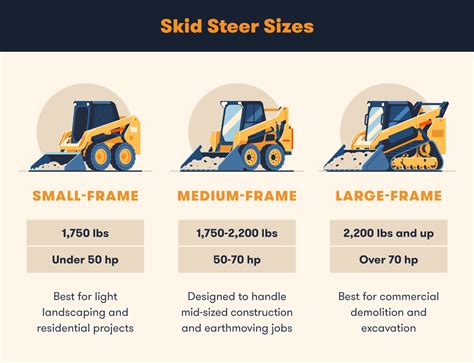what is skid steer lift capacity at 50 mean Every skid-steer has a rated operating capacity (ROC), which is the weight the loader arms can handle to any lifting height. If the machine can lift material off the ground—but .
excavation. Jun 22, 2020. #12. I am $100 for a large frame CTL. $90 an hour for large frame .
0 · skid steer track size chart
1 · skid steer size chart
2 · skid steer lift capacity chart
3 · skid steer comparison chart
4 · rated operating capacity skid steer
5 · case skid steer size chart
6 · bobcat skid steer size chart
7 · bobcat lift capacity chart
It's just a gimmick, the blade doesn't have enough angle to properly roll material off to the side and the blade is the same width as the tracks, so when you angle it, 1 track will be riding exposed to your material. Another big joke is the amount of time spent travelling while pushing a load, that puts more wear and tear on the drive system.
Learn how to choose the best skid steer loader for your job based on size, width, lift type, terrain, controls and attachment compatibility. Compare wheeled and tracked models, radial and vertical lift skid steers, and standard and joystick controls. Rated operating capacity (ROC) is 50% of tipping capacity under ideal conditions, as gatractorman mentioned, for wheeled machines and 35% of tipping capacity for tracked . The lift capacity — otherwise known as the rated operating capacity (ROC) — varies by the specific type of skid steer. Generally, skid steers can lift between 1,250 and . On wheeled skid steers operating capacity is 50% of the tipping load. On tracked skid steers the operating capacity is 35% of the tipping load. The tipping load is measured at .
skid steer track size chart
skid steer size chart
Skid steer load capacity is measured in Rated Operating Capacity (ROC). This is the maximum safe weight a skid steer can lift at a specific lift height and with a level machine. It’s important . Every skid-steer has a rated operating capacity (ROC), which is the weight the loader arms can handle to any lifting height. If the machine can lift material off the ground—but . A big skid steer can safely lift 2045 kilograms at 50% tipping load and a smaller model might have a rated operating capacity of around 590 kilograms at 50% tipping load. Of .
Learn how to calculate the rated operating capacity (ROC) and tipping load of skid steer loaders based on their size, model, and attachment. Find out the factors that affect the ROC, such as .
Learn how to choose the right skid steer loader for your project based on factors such as size, lift type, terrain, control type, and attachment compatibility. Find out the average . Learn how to choose the best skid steer loader for your job based on size, width, lift type, terrain, controls and attachment compatibility. Compare wheeled and tracked models, radial and vertical lift skid steers, and standard and joystick controls. Rated operating capacity (ROC) is 50% of tipping capacity under ideal conditions, as gatractorman mentioned, for wheeled machines and 35% of tipping capacity for tracked loaders. Currently, compact track loaders and multi-terrain loaders are .
rockland skid steer attachments
skid steer lift capacity chart

root grapple bucket skid steer
Learn how to calculate and understand the rated operating capacity (ROC) of skid steer loaders, which is the maximum weight they can safely lift. Find out how ROC, tipping load, hydraulic flow, and attachment types influence the performance and versatility of skid steers. The lift capacity — otherwise known as the rated operating capacity (ROC) — varies by the specific type of skid steer. Generally, skid steers can lift between 1,250 and 4,200 pounds, depending on the skid steer size, make, and model. On wheeled skid steers operating capacity is 50% of the tipping load. On tracked skid steers the operating capacity is 35% of the tipping load. The tipping load is measured at whatever height the loader reaches the farthest from the front axle.Skid steer load capacity is measured in Rated Operating Capacity (ROC). This is the maximum safe weight a skid steer can lift at a specific lift height and with a level machine. It’s important to remember that ROC is not the same as the skid steer’s overall weight.
Every skid-steer has a rated operating capacity (ROC), which is the weight the loader arms can handle to any lifting height. If the machine can lift material off the ground—but not more than a foot or two—this means the load exceeds the machine’s ROC.
A big skid steer can safely lift 2045 kilograms at 50% tipping load and a smaller model might have a rated operating capacity of around 590 kilograms at 50% tipping load. Of course, there’s a higher risk of tipping on uneven ground and lifting shouldn’t take place on slopes. Lift configurations.Learn how to calculate the rated operating capacity (ROC) and tipping load of skid steer loaders based on their size, model, and attachment. Find out the factors that affect the ROC, such as terrain, tracks, and lift type. Learn how to choose the right skid steer loader for your project based on factors such as size, lift type, terrain, control type, and attachment compatibility. Find out the average width of small, medium, and large skid steers and the benefits of radial and vertical lift skid steers.
Learn how to choose the best skid steer loader for your job based on size, width, lift type, terrain, controls and attachment compatibility. Compare wheeled and tracked models, radial and vertical lift skid steers, and standard and joystick controls. Rated operating capacity (ROC) is 50% of tipping capacity under ideal conditions, as gatractorman mentioned, for wheeled machines and 35% of tipping capacity for tracked loaders. Currently, compact track loaders and multi-terrain loaders are . Learn how to calculate and understand the rated operating capacity (ROC) of skid steer loaders, which is the maximum weight they can safely lift. Find out how ROC, tipping load, hydraulic flow, and attachment types influence the performance and versatility of skid steers.
skid steer comparison chart
The lift capacity — otherwise known as the rated operating capacity (ROC) — varies by the specific type of skid steer. Generally, skid steers can lift between 1,250 and 4,200 pounds, depending on the skid steer size, make, and model.
On wheeled skid steers operating capacity is 50% of the tipping load. On tracked skid steers the operating capacity is 35% of the tipping load. The tipping load is measured at whatever height the loader reaches the farthest from the front axle.
Skid steer load capacity is measured in Rated Operating Capacity (ROC). This is the maximum safe weight a skid steer can lift at a specific lift height and with a level machine. It’s important to remember that ROC is not the same as the skid steer’s overall weight.
Every skid-steer has a rated operating capacity (ROC), which is the weight the loader arms can handle to any lifting height. If the machine can lift material off the ground—but not more than a foot or two—this means the load exceeds the machine’s ROC. A big skid steer can safely lift 2045 kilograms at 50% tipping load and a smaller model might have a rated operating capacity of around 590 kilograms at 50% tipping load. Of course, there’s a higher risk of tipping on uneven ground and lifting shouldn’t take place on slopes. Lift configurations.Learn how to calculate the rated operating capacity (ROC) and tipping load of skid steer loaders based on their size, model, and attachment. Find out the factors that affect the ROC, such as terrain, tracks, and lift type.
sandbag filling attachment for skid steer

Learn how to select the best grease for your excavator pins and other machine parts based on the owner's manual, the grease consistency and the work conditions. Find out the different types of grease and their benefits for various applications.
what is skid steer lift capacity at 50 mean|skid steer comparison chart